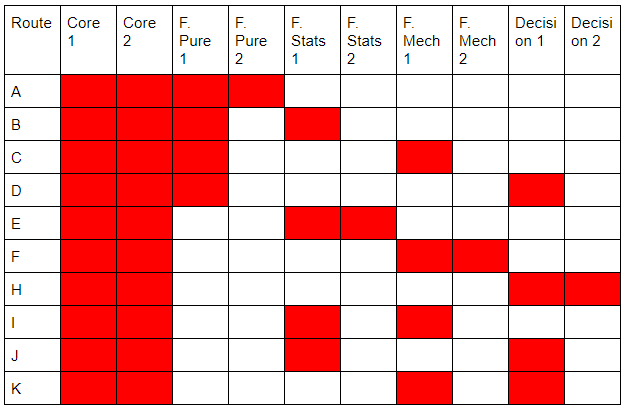A Level - Year 12 Book Now

Year 13 is the last stage of school journey, also a starting step towards university education. This year becomes very important as a student have to score the desired grades for his/her university admission or next academic journey.
In year 13, many student who have chosen more than 3 subjects for year 12, drop out one subject and keep strict focus on only three which are the mandatory requirement for their university choice.
The predicted grades from year 12 become handy to introspect and put in efforts where required.
The new A levels will be graded with the same A* to E pass marks as previously used.
Subjects: At Champs Learning, we have tuitions for following subjects for As levels – Year 12
1. Maths
2. Further Maths
3. Chemistry
4. Biology
5. Physics
6. Mechanics
Class Format:
We have both options available for these
tuitions; group as well as one to one. For
classroom sessions, we have small groups of
students.
The tuitions can be offered in both setting,
classroom as well as online.
Teachers:
The teachers are the expert in their
subjects and have a wonderful success record
with students. Most of the teachers are
working with schools and carry good number
of years teaching experience.
This phase is mostly discussion and
self-learning phase. The teachers will
empower every student to study on their own
and bring in the doubts for their subject to
look at. The marking scheme needs to be
followed but concept understanding is the
most important thing. This helps in solving
exams which are mostly application oriented.
Success: Champs Learning is proud for the great success of all our students. Each student at Year 13 – A level, has achieved minimum A grade in their respective subjects and secured admission to the desired course of their choice at university level. In 2020 – 25% of our student secured an admission in Oxbridge and Imperial college.
Pure Math
-
Algebraic Expressions
-
Quadratics
-
Equations & inequalities
-
Graphs & transformations
-
Straight line graphs
-
Circles
-
Algebraic methods
-
The Binomial Expansion
-
Trigonometric ratios
-
Trig identities & equations
-
Vectors
-
Differentiation
-
Integration
-
Exponentials & Logarithms
Applied Maths
-
Data Collection
-
Location & Spread
-
Representations of Data
-
Correlation & Linear Regression
-
Probability
-
Statistical Distributions
-
Hypothesis Testing
-
Constant Acceleration
-
Forces & Motion
-
Variable Acceleration
Mandatory Modules
Further Core Pure Maths
-
Proof
-
Complex numbers
-
Matrices
-
Further algebra and functions
-
Further calculus
-
Further vectors
-
Polar coordinates
-
Hyperbolic functions
-
Differential equations
Optional Modules
Further Pure Maths 1
-
Further Trigonometry
-
Further calculus
-
Further differential equations
-
Coordinate systems
-
Further vectors
-
Further numerical methods
-
Inequalities
Further Pure Maths 2
-
Groups
-
Further calculus
-
Further matrix algebra
-
Further matrix algebra
-
Further complex numbers
-
Number theory
-
Further sequences and series
Further Statistics 1
-
Discrete probability distributions
-
Poisson & binomial distributions
-
Geometric and negative binomial distributions
-
Hypothesis Testing
-
Central Limit Theorem
-
Chi Squared Test
-
Probability generating functions
-
Quality of test
Further Statistics 2
-
Linear Regression
-
Continuous probability distributions
-
Correlation
-
Combinations of random variables
-
Estimation, confidence intervals and test using a normal distribution
-
Other Hypothesis Tests and confidence intervals
-
Confidence intervals and tests using the t-distributions
Further Mechanics 1
-
Momentum and impulse
-
Work, energy and power
-
Elastic strings and springs and elastic energy
-
Elastic collisions in one dimension
-
Elastic collisions in two dimensions
Further Mechanics 2
-
Motion in a circle
-
Centres of mass of plane figures
-
Further centres of mass
-
Further dynamics
-
Further kinematics
Decision Mathematics 1
-
Algorithms and graph theory
-
Algorithms on graphs
-
Algorithms on graphs 2
-
Critical path analysis
-
Linear programming
Decision Mathematics 2
-
Transportation problems
-
Allocation (assignment) problems
-
Flows in networks
-
Dynamic programming
-
Game theory
-
Recurrence relations
-
Decision analysis
Combinations of Modules

-
Measurements and their errors
-
Particles and radiation
-
Waves
-
Mechanics and materials
-
Electricity
-
Further mechanics and thermal physics
-
Fields and their consequences
-
Nuclear physics
-
Astrophysics
-
Medical physics
-
Engineering physics
-
Turning points in physics
-
Electronics
-
Physical Chemistry
-
Organic Chemistry
-
Inorganic Chemistry
-
Biological molecules
-
Cells
-
Organisms exchange substances with their environment
-
Genetic information, variation and relationships between organisms
-
Energy transfers in and between organisms
-
Organisms respond to changes in their internal and external environments
-
Genetics, populations, evolution and ecosystems
-
The control of gene expression
Select Your Branch
Course Features
Maths
- Sessions per week : One
- Total no of sessions : 42
- Students per class : 3-5
Further Maths
- Sessions per week : One
- Total no of sessions : 42
- Students per class : 3-5
Physics
- Sessions per week : One
- Total no of sessions : 42
- Students per class : 3-5
Chemistry
- Sessions per week : One
- Total no of sessions : 42
- Students per class : 3-5
Biology
- Sessions per week : One
- Total no of sessions : 42
- Students per class : 3-5

